Crows are a major nuisance species known to cause a variety of damage such as destroying garden crops, harassing other birds and animals, making loud and obnoxious caws, and many more. This is why repelling crows should be a top priority when you first see signs of increased activity.
So, how to get rid of crows? Use bird netting, crow predator decoys, exclusive feeders, motion-sensor sprinkles, ultrasonic bird repellent, shiny objects, and bird spikes. Additionally, you can also sanitate your yards by removing food and water sources as well as existing or potential nesting areas.
This article discusses everything you need to know about crows, identifying them, their pros and cons, and the best ways of keeping crows away. Read further for more!
What Is a Crow?
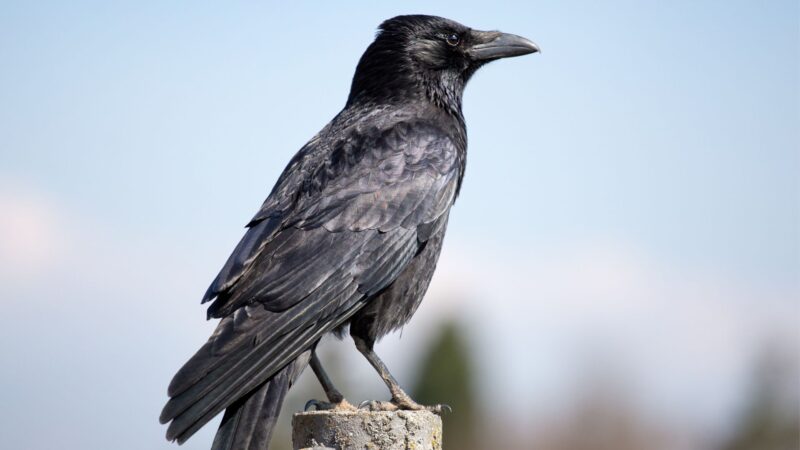
Keeping crows away first requires substantial knowledge about these birds. Crows are members of the genus Corvus, which ravens and rooks also belong to. There are two most widespread species in the United States: the American Crow, which are estimated to have over 31 million individual birds in the country, and the Fish Crow.
Here are more ways you can properly identify them:
Appearance
Completely black in plumage, legs, and beaks with a slightly iridescent, glossy look, crows are about 36 to 53 centimeters in length, 195 to 620 grams in weight, and have a wingspan of 85 to 100 centimeters. They have an average life expectancy of 6 to 7 years but they can live up to 17 years.
They are usually mistaken as ravens but crows are much smaller in size, have a less hoarse voice, slightly hooked beaks, and pointed wings and tails.
Habitat
Crows are well-adapted to a wide variety of habitats but they prefer open areas with trees nearby. They can be found inhabiting and nesting in agricultural areas, grasslands, forest edges, woodlots, urban parks, suburban neighborhoods, and even in coastal habitats such as empty beaches.
You can look for them by listening to their loud cawing. They can also be easily spotted near man-made landscapes such as garbage dumps, city parks, manicured lawns, campgrounds, cemeteries, athletic fields, and parking lots.
Feeding Behavior
Crows follow an omnivorous diet and are considered opportunistic feeders since they can eat a large assortment of food including grain crops, fruits and seeds, insects, small animals and/or their eggs, and even pet food, trash, and carrion.
These birds are also quite intelligent when foraging. For example, if they come across a food item that has a heavy shell such as a walnut, the crow will first fly into the air then drop the food item on a hard surface to break it open.
Nesting Behavior
They usually construct nests made out of sticks, twigs, and other soft plant material such as hair, bark fibers, grass, pine needles, or moss on tree trunks or treetops. Both the adult males and females build the nests and it takes about 9 days or more for them to finish it.
Although crows do not usually re-nest each breeding season, it is still possible for them to do so if they are disturbed early on. Crows also like to nest close to other individuals and are cooperative breeders. However, they are generally not considered a colonial species.
The Pros and Cons of Crows
Pros
- Effective pest control. Crows are essential in reducing insect and rodent populations. They usually band together to forage in groups near garbage and feed on insects surrounding it as well as grubs and grains.
- Importance in science. They make good subjects for research studies and journals. A recent 2022 study published by the Washington University in St. Louis exhibits how crows and ravens expanded rapidly around the world due to their long wings, big brains, body composition, and adaptability to different environments.
- Indicator of West Nile virus. According to the USDA APHIS Wildlife Services, since the virus attacks crows and other corvid species quite easily, their increasing death rate is used as an early indicator of virus prevalence in various areas in and out of the United States.
- Seed dispersal. Crows are known to disperse seeds and effectively establish seedlings in their respective habitats by frugivory methods, scatter hoarding, and seed caching. In fact, Sven August Heintze, a Swedish researcher, discovered that crows helped in the seed dispersal of 157 different plant groups.
Cons
- Damages crops. Crows are known to raid both garden and agricultural crops then consequently damage them. They have been documented to severely destroy fruits and vegetables such as guava, grapes, mangoes, apples, pawpaws, pears, stone fruits, and figs.
- Predators. Crows are notorious predators of small birds and their eggs and hatchlings, which has contributed to the decline in population of these birds. They are also known to harass, attack, and kill livestock such as newborn calves, poultry, and goat kids.
- Attacks people. Crows may also attack people in an attempt to steal food. In 2023, a group of crows attacked 10 people in just 20 minutes in a neighborhood in Singapore. This roused the worry of the residents as they may injure children and senior citizens.
- Nuisance in urban and suburban neighborhoods. Crows spread trash, block drain pipes, mangle electric wiring, disrupt power supplies, and release unsightly fecal droppings. Additionally, they tend to flock in large groups which can be quite noisy and pose a hazard to passing aircraft.
- Spreads diseases. These birds have been found to carry contagious histoplasmosis and gastroenteritis in their droppings.
Related: How to Get Rid of Cattle Egrets | Humane Solutions for Pest Control
Why Do You Have Crows Hanging Around?
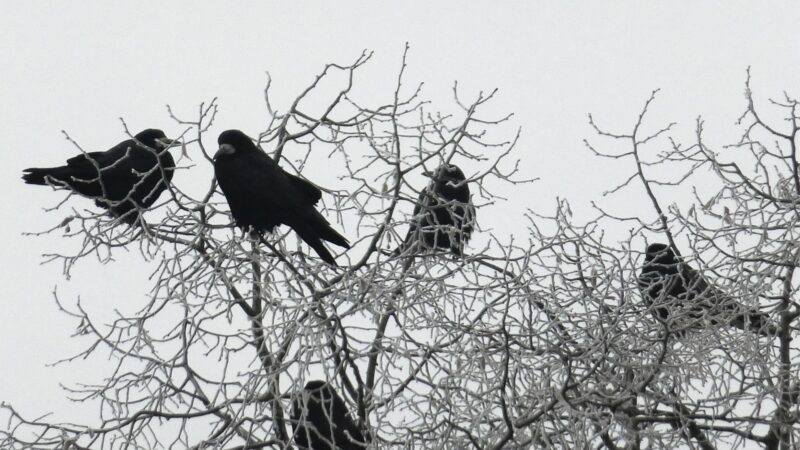
Seeing several crows in your yard, lawn, garden, or property? It may be because you have potential sources of food, water, nesting, and roosting areas for the birds in your area. This includes garbage, food waste in open-pit composts, and tall trees.
How to Get Rid of Crows?
Hopefully, by now you know a lot of essential information about crows. Let’s move on to the best ways to get rid of crows:
1. Use Bird Netting

Install bird netting preferably made of mesh, nylon, or polypropylene around your garden crops, trees, and shrubs. Tie it at the base of your desirable plants so that crows won’t be able to access them from below. Support the netting using wires, plastic pipes, or posts.
2. Use Decoys or Real Crow Predators
Predator decoys that resemble hawks, owls, eagles, raccoons, or snakes may scare crows away. However, they are an intelligent species and could realize right away that they are fakes. As such, this method should be used in combination with other methods in this list.
- Why Choose Our Bird Deterrent Garden Protectors: The horned owl...
- Not Just a Scarecrow: The fake owl for bird deterrent is made...
- No Battery Required: The owl decoy head rotates 360 degrees and...
- Easy To Install: The bottom of the owl has an anchor, you can...
- Realistic Design: The bird repellent imitation owl keep birds,...
- Bird Repellent Garden Protectors: 2 pack horned owl statue set...
- High Quality: Made of sturdy molded plastic and seems very...
- Unique Design: The head of our owl sculpture is connected to the...
- Widely Use: The bird repellent owl is both practical and...
- Tips: 1. Please note that this owl is for outdoor decoration,...
- Realistic Bird Deterrent Garden Protectors: The Great Horned Owl...
- High Quality: The fake owl for bird deterrent is made with...
- Not Just a Scarecrow: It is the perfect garden ornament. Besides...
- Easy To Install: The owl scarecrows has an anchor that can be...
- Wildlife Friendly Protector: The bird repellent owl keep birds,...
3. Use Feeders That Exclude Large Birds
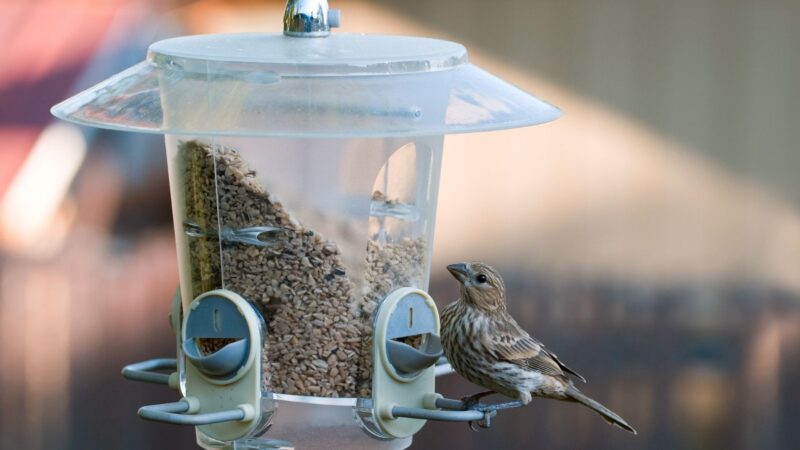
Purchase feeders that have smaller openings, perches, or have cages to keep crows away from them. They should be big enough for other desirable bird species but too small for crows.
4. Use Motion-Sensor Sprinklers
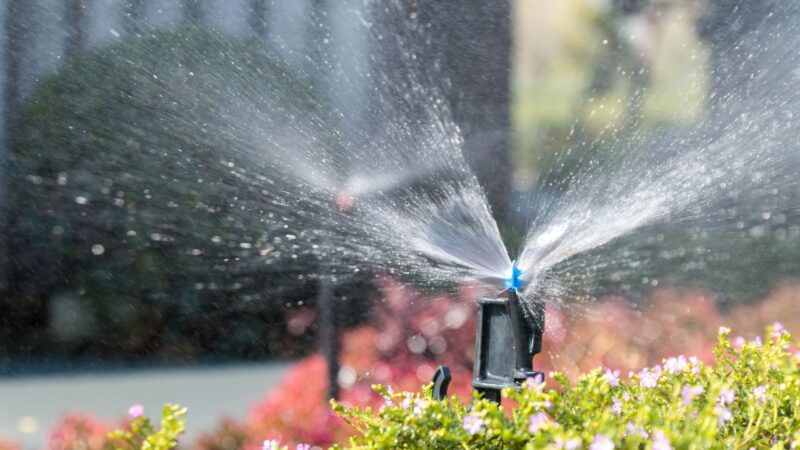
Motion-sensing sprinklers are devices attached to a hose and release high-pressure water when bird movement is detected. This is a humane way of harassing the birds from coming back into your property.
5. Ultrasonic Bird and Pest Repeller
These devices give off high-frequency crow deterrent sounds that are irritating to crows and even other birds but are otherwise inaudible to humans. Use products that offer a below-20kHz range as birds cannot hear the sounds beyond this frequency and those that are able to cover a wide range of area.
Other auditory frightening devices are recorded bird distress sound dispersal systems which can play either crow alarm calls or terrifying predatory sounds. This informs the birds that your property is unsafe for them to enter.
- 【Motion Sensor Design】PIR motion detector system detected...
- 【Solar Powered & Waterproof】Ultrasonic Animal Repeller...
- 【Easy to Use】This squirrel repellent has 120 degrees infrared...
- 【How to Work】Blue light indicates the charging status.Turn on...
- 【Safe and No Harm Drive】Rabbit repellent outdoor uses a...
- 【4 Modes】This solar powered ultrasonic pest repeller uses the...
- 【Easy Installation】 Installing the raccoon repellent is...
- 【Human & Environmentally Friendly】 Our solar animal repeller...
- 【Solar and USB Charging, IP55Waterproof】 Equipped with a...
- 【Best Service】 For any inquiries regarding our product's...
- Bird Preventer: The Bird-X Balcony Gard is an ultrasonic bird...
- Wide Coverage: Our weather-resistant and fully programmable bird...
- Versatile Bird Decoy: With a sound pressure of 90 dB at 1 meter...
- Humane and Reliable: With our ultrasonic bird preventer, you can...
- Easy Operation and Installation: Featuring motion-activated and...
6. Hang Something Shiny Throughout Your Yard
Objects with shiny or reflective material can be used as a visual deterrent for crows, so hang them all throughout your property to keep crows away. You can use mirrors, CDs, eyespot balloons, aluminum foil, or reflective tape. Since the birds get used to these, make sure to relocate them every now and then to ensure their effectiveness.
7. Install Bird Spikes
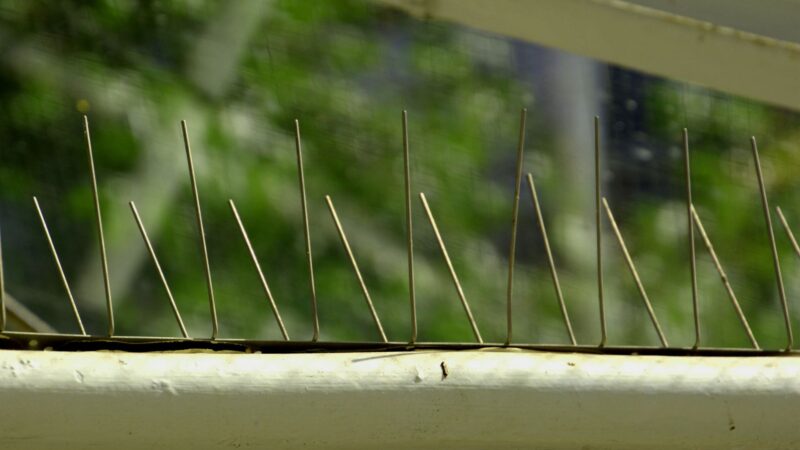
Bird spikes work as physical crow deterrents by preventing them from landing and roosting on surfaces such as windowsills, roofs, and ledges. They may be plastic or stainless-steel and are quite easy to install. Don’t worry, these are harmless devices that won’t hurt the birds.
8. Keep Your Yard Clean
Keep your property free from any potential food sources by cleaning them up and disposing of them if necessary. This also includes closing trash cans and compost pits as crows are opportunistic feeders.
9. Make High Sounds and Noises
Deter crows by making loud noises using air horns, whistles, banging pots and pants, beating on tin sheets, or barreling with clubs. These, however, only provide short-term relief from the birds so use it in combination with other methods.
10. Remove All Food and Water Sources
As mentioned above, removing existing and potential sources of food and water in your property is a great way of getting rid of crows in yards.
11. Remove Nesting Areas
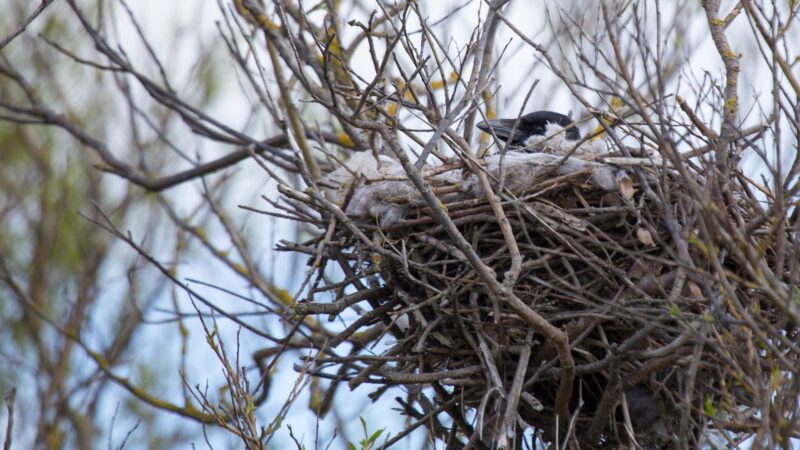
Crow nest removal is essential if you spot any of their nesting sites on your property. This is because they tend to return to the same nest annually. Ensure that the nests do not have eggs or hatchlings in it before disposing of it.
Related: How to Get Rid of Starlings | Effective Techniques for Pest Control
How to Get Rid of Crows but Not Other Birds?
Looking forward to feeding other bird species or you simply want anything but crows in your property, some of the methods you can use to do so are using bird spikes, netting, cage-style feeders, and predator decoys to keep them away.
Related: How to Get Rid of Blackbirds From Bird Feeder? | 8 Effective Ways to Know
How to Get Rid of Crows Pecking on Windows?
Crows may suddenly strike or peck on them as they mistaken their reflection for another crow. These birds are highly territorial, which makes more sense why they would attack their own reflection. To keep this from happening, use curtains, shades, tape, or blinds to properly cover your windows.
How to Get Rid of a Crow’s Nest?
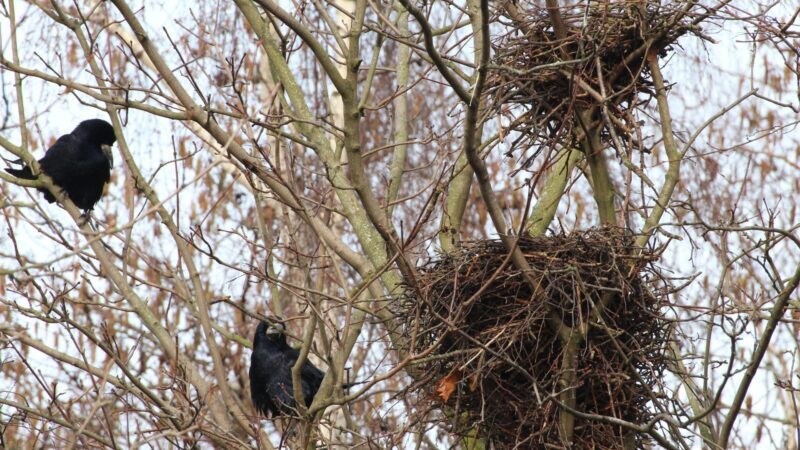
Crows are under the protection of the Migratory Bird Treaty Act which makes nest removal illegal during breeding season, but you can remove it once the crows abandon the nest and there are no more eggs or hatchlings inside it.
To remove, simply cut off the tree branch it is attached to. You can also just knock the entire nest down using a long stick. Make sure you do not catch any of the debris when doing these methods as the nests are unsanitary and can be a hub for diseases.
Related: How to Prevent Birds Nesting in Roof? | Information and Control Guide
Why Getting Rid of Crows Is Important?
Crow removal from your lawns, yards, and property using humane methods is imperative since they are known to damage garden and agricultural crops, are notorious harassers and predators of birds and other animals, may attack people, cause disruptions in peaceful urban and suburban neighborhoods, and transmit diseases.
However, this does not mean that we should totally discredit their vital ecological roles in controlling insect and rodent populations, scientific research, as indicators of viruses, and in seed dispersal.
Related: How to Get Rid of Chimney Swifts? | Proven Strategies and Solutions
List of Sources
All About Birds. (n.d.). American Crow.
Eaton, A. T. (n.d.). Bird Damage Prevention for Northern New England Fruit Growers.
Godfrey, L., & Hurley, J. (n.d.). IPM Action Plan for Nuisance Birds.
Hurley, J. A. (2020). Birds, Bees and Bats: What do you do when you encounter them?
Indiana Department of Natural Resources. (n.d.). American Crow (Corvus brachyrhynchos).
Knight, J. E. (n.d.). Non-Chemical Bird Control.
- How to Get Rid of Copperheads | Practical Guide - August 27, 2023
- How to Get Rid of Corn Snakes | What Makes Them Aggressive? - August 27, 2023
- How to Get Rid of Alligators | Safety Measures and Removal Methods - July 16, 2023






